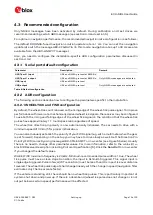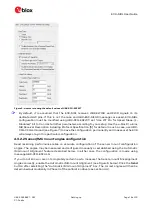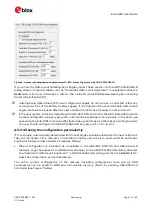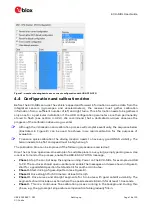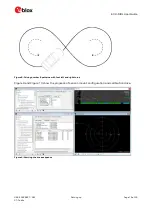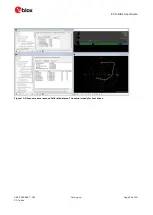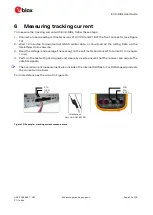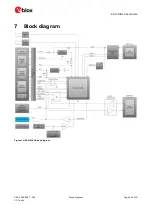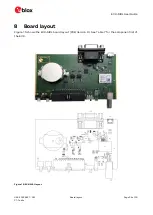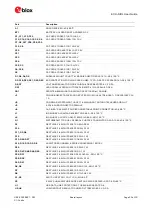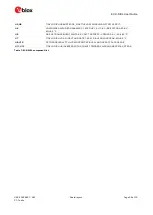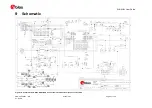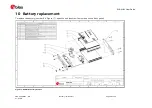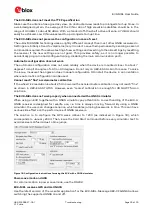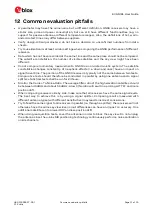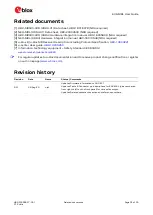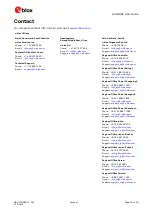
EVK-M8L User Guide
UBX-20028627 - R01
Troubleshooting
Page 29 of 33
C1-Public
11
Troubleshooting
My application (e.g. u-center) does not receive anything
Make sure that the USB cable is properly connected to the evaluation unit and the PC and that USB
drivers are installed correctly. By default, the evaluation unit outputs NMEA protocol on Serial Port 1
at 9600 Bd and on the USB.
My application (e.g. u-center) does not receive all messages
When using UART, make sure the baud rate is sufficient. If the baud rate is insufficient, GNSS
receivers based on u-blox M8 GNSS technology
will skip excessive messages. Some serial port
cards/adapters (i.e. USB to RS232 converter) frequently generate errors. If a communication error
occurs while u-center receives a message, the message will be discarded.
My application (e.g. u-center) loses the connection to the GNSS receiver
u-blox M8 positioning technology and u-center have an autobauding feature. If frequent
communication errors occur (e.g. due to problems with the serial port), the connection may be lost.
This happens because u-center and the GNSS receiver both autonomously try to adjust the baud rate.
Do not enable the u-center autobauding feature if the GNSS receiver has the autobauding flag
enabled.
The COM port does not send any messages
Make sure that the slide switch at the front panel is set to I2C and not SPI. In SPI mode the RS232
pins on the DB9 connector are switched off and the RxD and TxD output at the front panel are used
for SPI (MISO, MOSI).
☞
After changing the slide switch, always reset the EVK, otherwise the change will not take place.
Some COM ports are not shown in the port list of my application (e.g. u-center)
Only the COM ports that are available on your computer will show up in the COM port drop-down list.
If a COM Port is gray, another application running on this computer is using it.
The position is inaccurate by a few dozen meters
u-blox M8 GNSS technology starts up with the WGS84 standard GNSS datum. If your application
expects a different datum, you will most likely find the positions to be off by a few dozen meters. Do
not forget to check the calibration of u-center map files.
The position is inaccurate by hundreds of meters
Position drift may also occur when almanac navigation is enabled. The satellite orbit information
retrieved from an almanac is much less accurate than the information retrieved from the ephemeris.
With an almanac-only solution, the position will only have an accuracy of a few kilometers but it may
start up faster or still navigate in areas with obscured visibility when the ephemeris from one or
several satellites have not yet been received. The almanac information is NOT used for calculating a
position if valid ephemeris information is present, regardless of the setting of this flag.
In NMEA protocol, position solutions with high deviation (e.g. due to enabling almanac navigation) can
be filtered with the Position Accuracy Mask. UBX protocol does not directly support this since it
provides a position accuracy estimation, which allows the user to filter the position according to their
requirements. However, the “Position within Limits” flag of the UBX-NAV-STATUS message indicates
if the configured thresholds (i.e. P Accuracy Mask and PDOP) are exceeded.
TTFF times at startup are much longer than specified
At startup (after the first position fix), the GNSS receiver performs an RTC calibration to have an
accurate internal time source. A calibrated RTC is required to achieve minimal start-up time.
Before shutting down the receiver externally, check the status in MON-HW in field “Real Time Clock
Status”. Do not shut down the receiver if the RTC is not calibrated.

